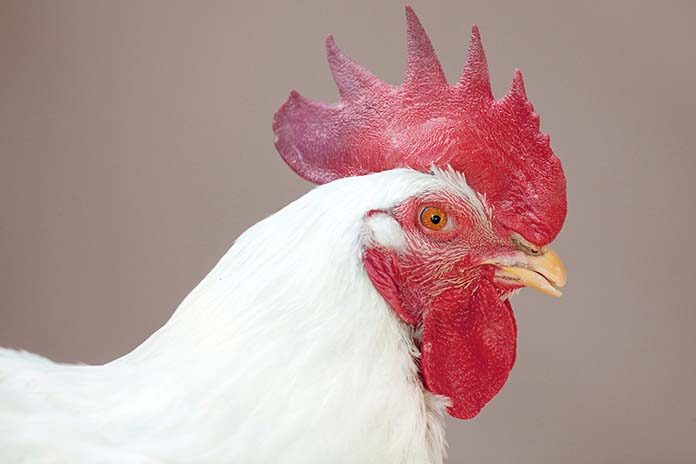
The role of males in poultry breeding is extremely important. Each male is responsible for fertilizing 10 or more females. Each hen produces at least 140 chicks at 60 weeks of age, so that each male is responsible for producing at least 1,400 day-old chicks. Geneticists at Cobb select for better feed conversion and robust health to reduce broiler production cost. This advance also benefits parent stock males, which are now using feed ever more efficiently and are better able to withstand challenges.
The rearing period
Cobb males, for example, have an excellent appetite, which helps them to grow efficiently from the first few weeks. This is essential for good development of the internal organs, immune system and skeletal frame but, most importantly, the reproductive Sertoli cells responsible for fertility. Sertoli cells start to develop as early as two weeks and are essential for sperm formation later. Weight, protein and calorie intake are essential for their proper development.
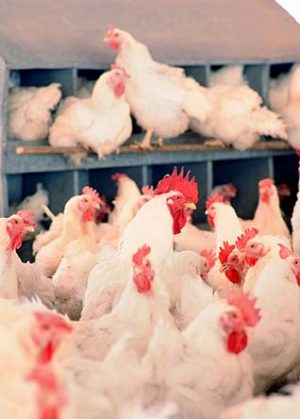 Control of frame size is as important as bodyweight control to prevent males becoming very big later. Select males as early as first week, with another selection at three to four weeks to maintain a high level of uniformity (>90%).
Control of frame size is as important as bodyweight control to prevent males becoming very big later. Select males as early as first week, with another selection at three to four weeks to maintain a high level of uniformity (>90%).
Ensure a good skeleton frame with long shank length in the first four weeks. Fleshing is better controlled later and very small males can be culled. Fleshing Score should be 3 at this stage. After 10-11 weeks of age the skeletal development is almost complete and select males into homogenous groups for bodyweight and frame. From 10 weeks males should be reared at a density of 3-4 males/m2 for an optimal development. At this stage a fleshing score of 2-2.5 is required.
From 18 weeks the males must start to show red combs, and start crowing. If not, they are behind, probably due to over restriction on feed or very low light intensity. But we also don’t want the males to be sexually maturing earlier than females. We need to achieve sexual synchronization. Focus on the feed levels from 17-27 weeks – this is when you can make or break a flock. Feed a low crude protein male diet (12%-14%), with adequate weekly increments, to control bodyweight and breast development.
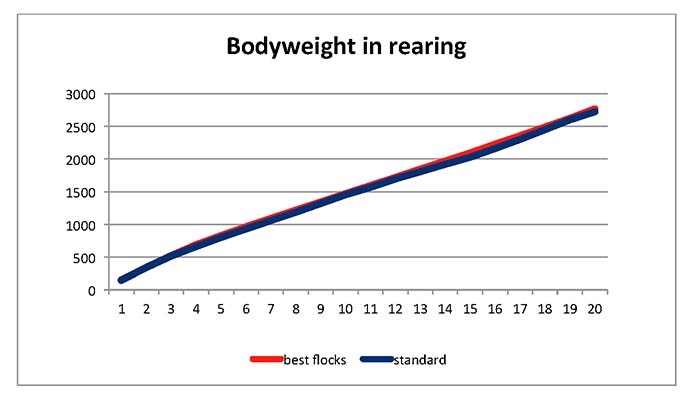
The top 25% performing parent flocks in the region showed the following male bodyweight profile in rearing:
Testes growth is very rapid once light stimulation begins. Some mature sperm is formed, but the male is still not sexually mature. Management now can have a dramatic impact on early and peak hatchability. You need to achieve the weekly bodyweight gain in the first four weeks after light stimulation. Ensure that bodyweight profile is parallel to standard between 20-29 weeks to ensure optimal testicular growth, especially at 24 weeks. This is when male fertility is determined.
The top 25% parent stock performer in the region showed the following bodyweight profile after 20 weeks:
In general, you can mix males as early as 20 weeks but when males are more sexually mature than females, mix only 5% males and assess receptiveness of females after one week. If males are still overaggressive, keep the same and reassess after one week.
A normal mating ratio of 8.5% males is sufficient to achieve up to 95% fertility. Good sexual synchronization is extremely important. Starting flocks on an 8% ratio for males through 25-30 weeks and then going up to 9% seems to boost early fertility and lower hen mortality. Generally, if the weight differential exceeds 40%, female receptivity will be disrupted resulting in reduced mating efficiency. Then you may need to place fewer males (ie 7% ratio) to prevent male aggression, topping up to 8.5% after two weeks. The quality of the males is important as some flocks have only 5% males at the end of production, yet still with excellent fertility.
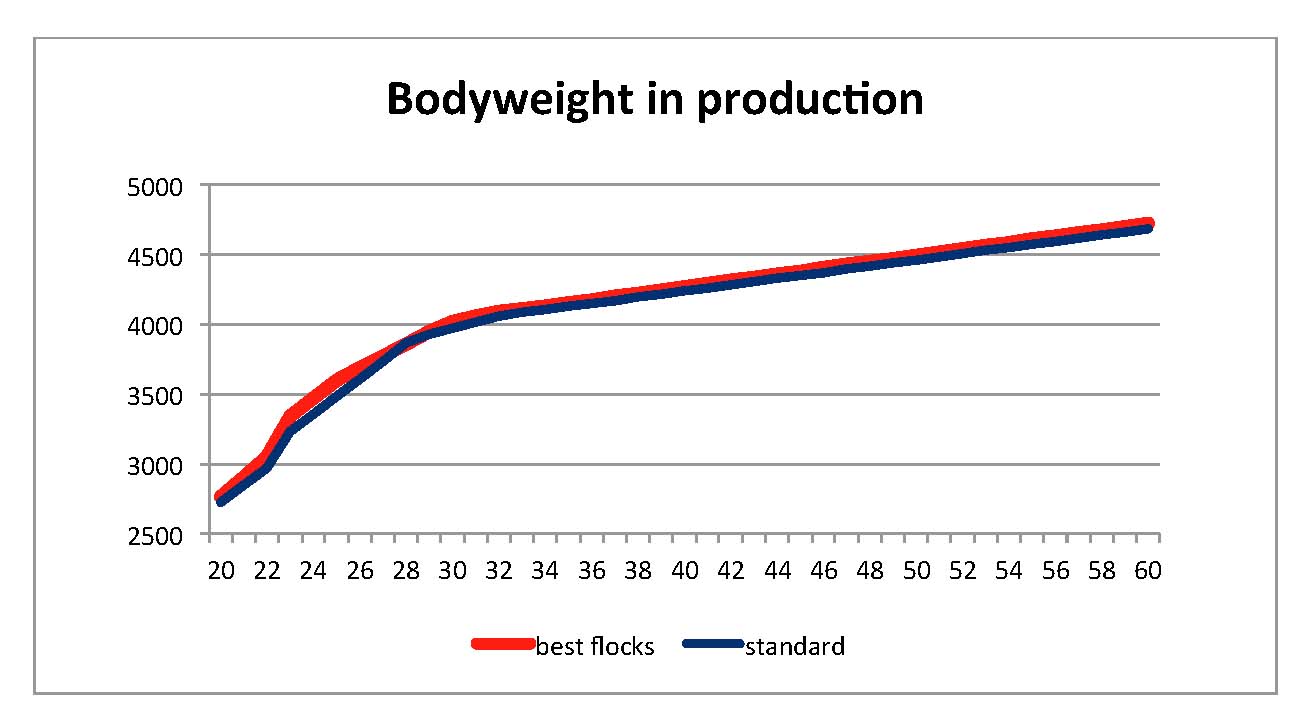
The laying period
Ensure that males find water immediately after transport so they don’t become dehydrated and lose condition.
Adopt the sex separate feeding. Cobb males consume feed efficiently. They may access the female feeders, too, after mixing. Keep an eye on the male bodyweight profiles to prevent overgrowth.
With sex separate feeding, males need to identify their specific feeders, so keep the same type of male feeder in rearing and production.
Transfer in three to seven days according to feeder type, as shown in the table below
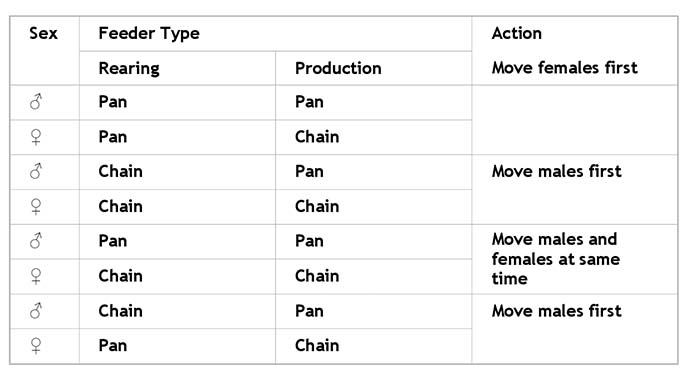
Poor dietary management and stress can lead to a regression of the male reproductive system and decreased fertility. A reduction of 4 to 10% in feed consumption can result in lower sperm production.
Because sperm formation requires 15 days, any factor affecting sperm formation can affect fertility for at least 15 days. Early correction of male infertility is essential (eg, adding 5 grams extra feed).
Feed the males by monitoring the breast muscle development and feather quality:
– Young males 18-30 weeks must have scores 2 and 3.
– Post 35 weeks try to maintain 70% on a score 3, a few 4s but no 5s yet. Only from 50 weeks onwards should you see some 5s.
– Observe the feathers very carefully; feather loss around the back, thighs and wings is a sign of energy deficiency.
– Score the males every three weeks.
When you see a change in breast muscle score:
- 2s are increasing, increase the feed by 3-5 grams in the same week.
- If you see the 4s and 5s developing, increase feed by 1-2 grams to stimulate mating activity. That will control the further development of breast muscle.
- Feed allocation is calculated at 2.8-3.0% of the weight for best performing flocks.
- High nutrient density male feed is not recommended as with low feed levels birds may lose uniformity as feeding time is so short.
Good feed distribution is essential, ensuring the males get equal opportunity and appropriate daily feed allocation. Feeding space of 20 cm/male is the minimum. Feed the males in one place or one row only. Males need competitive feeding to control their feed intake and weekly growth.
Evaluate the quality of males at 40-42 weeks by physical examination. Cull males with emaciated breast (score<2), atrophied and pale combs, leg issues, de-feathering and crooked beak.
Conclusion
Male uniformity is the key to high hatchability. Start male grading at three to four weeks ensuring good skeleton development. Rear three to four males/m2 for optimal development. Control male body weight according the breed standard and maintain fleshing between 2-2.5 in rearing and beginning of production.
For good female acceptance a good sexual synchronization between male and female is extremely important. At 24 weeks 8.5% good quality males are enough. Ensure males don’t lose condition, but avoid over fleshing to maintain high hatchability. A male feed can help to control male bodyweight.

















